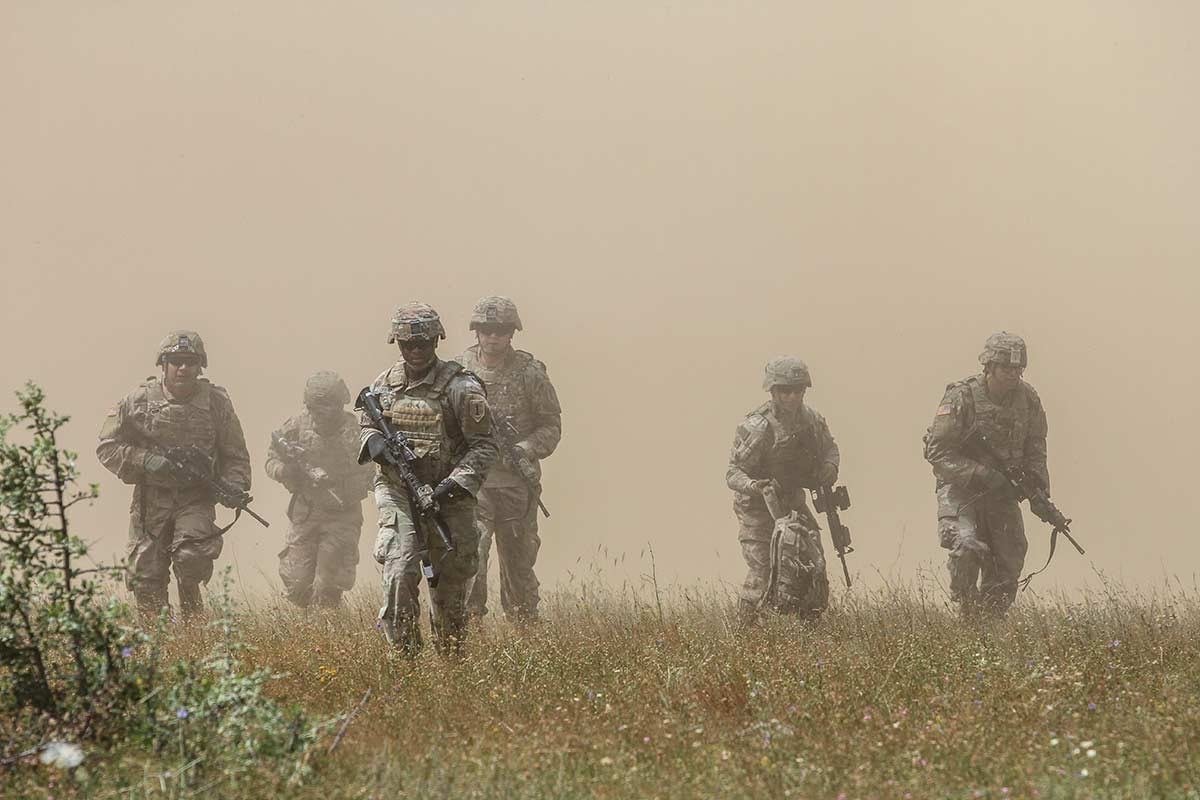The Army’s most recent annual series of experiments for soldiers at the tactical level showcase new tools for warfighting that could benefit troops at the company level and below.
This year the Army Expeditionary Warrior Experiment looked at new and updated technology from a host of presenters over nearly six months.
The key areas the Army cares about at the tactical level include: cross-domain maneuver; autonomous resupply; Group 2 intelligence, surveillance and reconnaissance platforms; artificial intelligence; alternative fuel power generation, and soldier health monitoring. The experiment team looked at 42 concepts across those six major areas.
RELATED

Harry Lubin, head of the Fort Benning, Georgia-based Maneuver Battle Lab Live Experimentation Branch, and Justin Strayer, the lab’s lead analyst, recently spoke with Army Times about AEWE, how it works and what the Army learns.
The experiments kicked off back in 2004 and were originally called the “Air Assault Expeditionary Force” experiments. That first year started with a dozen technologies to review. As of last week, the group had 113 submissions for the next AEWE, scheduled to start in October, Lubin said.
The following items that soldiers carry now all got their start at AEWE:
- The soldier-borne sensor, a hand-sized microdrone called the “Black Hornet” was refined through AEWE 2015 to 2019 before fielding;
- Nett Warrior, a smartphone-based integrated dismounted leader situational awareness system used during combat operations was presented and refined from the first 2004 AEWE and continues to be used in the experiments;
- An electronic warfare dismounted passive direction finder saw assessments in 2016 and 2018 and is now in use at the Combat Training Centers;
- The Enhanced Night Vision Goggle with fused infrared capability was refined over five years at the AEWE from 2013 to 2018 before fielding and led to the currently fielding ENVG-Binocular.
Some of this year’s early success was in tactical autonomous resupply, Lubin noted.
The XVIII Airborne Corps first endorsed a resupply capability that could carry an 80- to 150-pound payload in the 2020 experiments. That was refined for a more focused demonstration this year and is headed to a Corps’ Infantry Brigade Combat Team for further evaluation and troop trials.
The same system should also fill the need of a similar Marine Corps program that is expected to field in 2023.
A rucksack portable drone that saw early development beginning in 2011 is set to field this summer.
Other items that have shown promise included a suppressed M240 machine gun, high-performance 7.62mm ammunition with lighter steel cartridge casing, an enhanced incendiary thermite grenade and a standoff chemical detection system that can be integrated into unmanned ground sensors.
The six areas of focus and an umbrella goal of working tech into Project Convergence, which incorporates AI and machine learning on the battlefield, guide what tech they evaluate.
Priorities can change over time. Alternative fuel power generation was part of the first experiments in 2004. Drone evaluations came in 2005. Some of the cross-domain maneuver problems have emerged from 2019 until last year. Autonomous resupply at the tactical level was first examined in 2020. This was the first year that AI at the tactical edge was considered.
But whether submissions fit neatly into a defined problem or not, good ideas are welcome.
“We almost serve as an innovation engine down here,” Lubin said. “We’re willing to take any tech at any level as long as it shows a potential for a significant capability that can be put into any exercise.”
And exercise is key.
The MBL brings a company-minus of 61 experienced soldiers — the Army’s full-time tactical experimenters — along with a standard opposition force from a regular Army unit and foreign participants to put the tech through its paces in a field environment.
This year saw Alpha Company, 1st Battalion, 29th Infantry Division, along with its battalion headquarters, a United Kingdom infantry section from the 1st Battalion, Royal Irish Regiment, and a robotics section from the Dutch Army’s 13th Light Armored Brigade.
The opposing force was Bravo Company, 1st BN, 29th ID, and elements of the 199th Infantry Brigade.
They worked through live-fire and networked force-on-force scenarios with much of the gear that was handed to them. And the companies, developers and researchers trying to improve their ideas participate as well.
The AEWE is exactly that, an experiment. So, presenters can learn directly from soldiers handling the gear on what works, what doesn’t and what they didn’t consider before it got to the field.
Ultimately, the experiments are to find what works and what soldiers can use and then get it to units or Army programs that can put it through its paces for potential fielding.
“It all comes down to outcomes,” Lubin said.
The staff at MBL compile an annual “insights report” from the six-month experiment and get that out to all of the major units and programs to see who’s interested and might need what’s being offered.
Todd South has written about crime, courts, government and the military for multiple publications since 2004 and was named a 2014 Pulitzer finalist for a co-written project on witness intimidation. Todd is a Marine veteran of the Iraq War.




